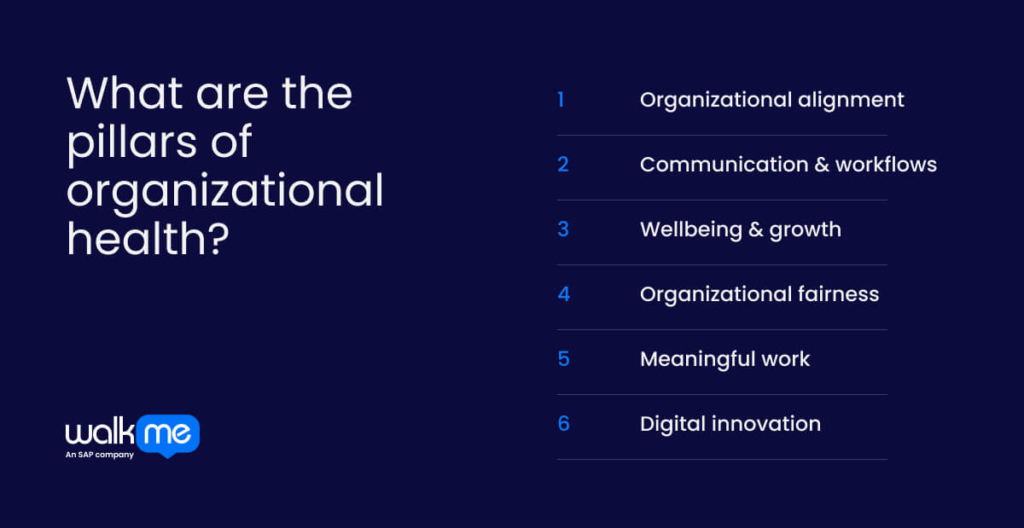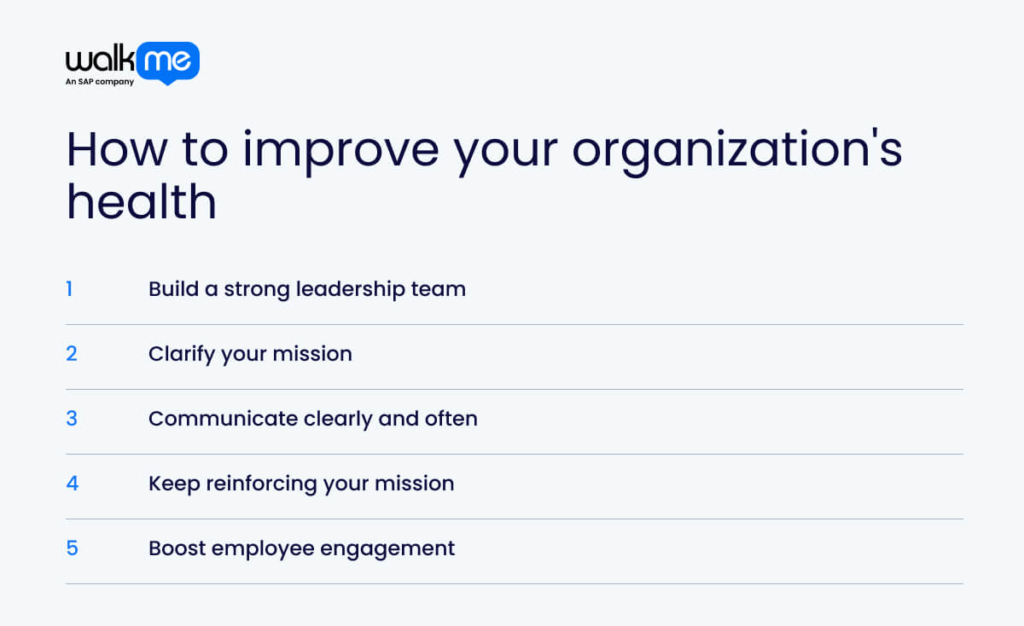Organizational health has been a buzzword for some years, but do you know what it means?
Organizational health is a company’s overall well-being, focusing on factors like employee engagement, clear communication, and alignment with company goals.
McKinsey’s Organizational Health Index (OHI) shows that healthy organizations deliver three times the total shareholder returns (TSR) of unhealthy organizations, regardless of industry.
This article will explore organizational health, its importance, key pillars, and strategies for measuring and improving it.
What is organizational health?
Organizational health is how well a company works, adapts, and stays successful over time. One mistake people make is equating organizational health solely with profits.
Modern metrics include alignment, execution, and a supportive organizational culture. A healthy organization ensures everyone knows their role, feels supported, and can share ideas openly. It can handle problems quickly and stick to its values when making decisions.
This focus helps businesses grow, retain employees, and prepare for market changes. Companies with strong organizational health often perform better, have happier employees, and stay ahead of their competitors.
Why is organizational health important?
Organizational health matters because it’s the foundation of lasting success. It provides businesses with clear metrics to measure alignment, track progress, and identify areas for improvement.
A company can’t thrive on profits alone; it needs strong teamwork, trust, and clear communication. McKinsey’s research also shows that organizational health is the best predictor of long-term value creation and competitive advantage.
Employees who feel valued and supported work better together and solve problems faster. Healthy organizations are also more adaptable, which is crucial in a world that changes quickly.
Even the smartest strategies can fail without good organizational health because people aren’t motivated or aligned.
Employers should create a place where everyone, from employees to leaders, can grow and succeed together, driving better results and long-term stability.
What are the pillars of organizational health?

Now that you understand organizational health and its importance, it’s time to explore the pillars.
These pillars will help you build a strong foundation for sustained success, drive performance, and navigate challenges with resilience.
Let’s examine the pillars of organizational health:
Organizational alignment
Organizational alignment ensures everyone in a company is on the same page. When leaders and employees understand the company’s goals and their role in achieving them, things run smoothly. Alignment ultimately means creating a shared sense of direction that drives consistent action across the entire organization.
Misalignment can cause confusion, wasted effort, and missed opportunities. But when the whole team knows where they’re headed and how they contribute, productivity increases and success becomes more achievable.
Communication & workflows
Clear communication and organized workflows are essential for a healthy organization. When people share information openly, everyone knows what’s happening and what’s expected. Well-organized workflows help tasks get accomplished without confusion or delays. If communication is unclear or processes are messy, things can go wrong, and work can pile up.
For a company to succeed, everyone must know how to articulate themselves and follow a clear communication strategy to complete their work efficiently.
Wellbeing & growth
Wellbeing and growth are key to a strong organization. Employees who feel mentally and physically supported perform better and stay motivated. A company focusing on employee wellness encourages a positive environment where people feel valued and can balance work and life.
Growth opportunities, like training and career development, keep employees engaged and help them reach their full potential. People who feel good and see a path forward contribute more to the company’s success.
Organizational fairness
Organizational fairness is about treating everyone equally and with respect. It is part of ethical leadership and means ensuring all employees have the same opportunities to succeed, regardless of their background or role. When decisions are made openly and consistently, people trust the system more.
Fairness boosts morale, reduces conflicts, and helps employees feel valued. It also ensures that the workplace remains inclusive, where everyone can thrive without fear of bias or favoritism. A fair organization attracts and retains talent, creating a healthier, more productive environment.
Meaningful work
Meaningful work is when employees feel their tasks matter and align with their values. It goes beyond just getting a paycheck and is more akin to having a sense of purpose in what you do. When people understand how their work contributes to the bigger picture, they’re more motivated and engaged.
Meaningful work creates a deeper connection to the organization, improving job satisfaction and retention. It encourages employees to take pride in their roles, which leads to higher productivity and a stronger sense of team unity.
Digital innovation
Digital innovation helps businesses find new ways to solve problems and improve processes. In a healthy organization, employees are encouraged to think creatively, experiment, and share ideas without fear of failure. This creates a culture where innovation becomes part of the company’s DNA, driving progress and adaptability.
When teams embrace innovation, they stay ahead of the competition and are better equipped to handle change. It keeps the organization dynamic and responsive, making employees feel more engaged and valued for their contributions.
How to measure organizational health
Now that you’re familiar with the pillars of organizational health, you’ll probably want to know how to measure it.
Measuring organizational health involves assessing how well these pillars function within your company. It measures leadership, accountability, and direction, among other things.
McKinsey’s Organizational Health Index (OHI) is another popular tool for measuring organizational health. It evaluates factors like leadership effectiveness, culture, and strategy execution.
However, this information isn’t publicly available, so we’ve created our own metrics for assessing organizational health.
Let’s take a closer look at how to measure organizational health:
Leadership
Leadership plays a key role in measuring organizational health. Good leaders guide the company’s direction, help solve problems, and make sure everyone is working toward the same goals.
To measure leadership, you can look at how well leaders communicate, inspire their teams, and solve issues. Asking employees for feedback and doing regular check-ins can show how effective leaders are. Strong leadership helps create a positive work environment, while weak leadership can hurt the organization’s overall health.
Accountability
Accountability is key to understanding how healthy an organization is. It means everyone, from leaders to employees, is responsible for their actions and work. When people are accountable, they’re more likely to stay focused and do their best.
You can measure accountability by looking at how well tasks are completed on time and how often people keep their promises. If accountability is weak, relationships can deteriorate, and trust within the team can break down.
Direction
Direction is about having a clear path for the company’s future and ensuring everyone knows where it’s going. To measure it, look at how well employees understand the company’s goals and if leadership communicates them.
When direction is strong, employees are focused and motivated. If unclear, confusion can spread, and people may lose trust in the leadership. A strong direction helps everyone work together toward the same purpose and achieve success.
Coordination
Coordination shows how well different teams and departments work together. To measure it, observe how smoothly information flows across the organization and if people collaborate effectively. If teams are disconnected or communication is poor, work can get duplicated or missed.
Good coordination means everyone knows their role and how their work fits into the bigger picture. It’s key to ensuring tasks are completed on time, and the organization functions as a unified whole.
Motivation
Motivation influences how employees approach their work and affect their performance. When motivation is high, people are more likely to take initiative and go beyond what’s expected. Low motivation can lead to disengagement, missed opportunities, and resistance to change.
Motivated employees are more connected to the organization’s goals, which helps the business succeed. Keeping employees inspired and valued is important for maintaining a positive work environment.
Values
To measure values, observe how consistently they are reflected in everyday actions and decisions. Look at how employees behave and interact with each other. Do they live up to the company’s values?
Feedback surveys can also reveal how well employees understand and align with the organization’s values. If there’s a gap between what the company values and what employees experience, it might signal a need for better communication or a shift in culture.
How to improve your organization’s health

Now you know how to measure organizational health, it’s time to put everything you’ve learned so far into action and improve it.
We’ve compiled a list of actionable steps to enhance leadership, communication, and overall company performance.
Let’s take a closer look at how to improve organizational health:
Build a strong leadership team
Building a strong leadership team goes beyond hiring the best talent. It involves team cohesion and leading with purpose. We all talk about strong leadership, but what does that mean?
It’s not enough for leaders to have experience; they must align on vision, communicate clearly, and hold each other accountable.
A unified leadership team sets the tone for the entire organization. If leaders aren’t on the same page, employees feel the disconnect. Prioritize developing leadership skills that build trust, clarity, and collaboration. When leaders are aligned, organizations can follow their lead with confidence.
Clarify your mission
Clarifying your mission is about defining a clear purpose that guides every decision and action within the organization. Many companies claim to have a mission, but if employees can’t articulate it or it doesn’t align with daily tasks, it’s just words.
A strong mission provides direction, helping employees understand how their work contributes to a larger goal. It’s essential that your mission is meaningful and resonates with your team, not just leadership. When everyone understands and believes in the mission, the organization becomes more focused and driven.
Communicate clearly and often
Clear communication is essential. When leaders share updates consistently and honestly, employees stay informed and focused. Avoiding vague language or waiting for quarterly reports helps everyone understand the company’s direction. Misunderstandings create mistakes, and productivity suffers when employees aren’t in the loop.
Leaders must also encourage open feedback. Communication goes both ways. Frequent, transparent dialogue boosts trust and helps teams stay aligned. Without this, people work in silos, wasting time and effort. Good communication keeps everyone connected and drives results.
Keep reinforcing your mission
Reinforcing your mission is crucial for keeping everyone on track. It’s easy to lose sight of goals as daily tasks pile up, but constantly reminding your team of the bigger picture helps them stay motivated. Leaders should weave the mission into conversations, decisions, and strategies.
Employees feel more connected and engaged when they see how their work contributes to the company’s core purpose. It’s not enough to mention the mission once and move on. Consistently reinforcing it creates a sense of shared purpose that drives productivity and aligns efforts across the organization.
Boost employee engagement
Boosting employee engagement in the modern workforce goes beyond perks or incentives. Employee engagement makes people feel genuinely valued and involved in the company’s success. When employees understand how their work impacts the organization, they take more pride in what they do.
Regular feedback, recognition, and opportunities for growth are key to keeping people engaged. Encourage open communication, where team members feel safe to share ideas and concerns. Engagement helps create an environment where people care about the company’s mission and feel empowered to contribute to its growth.
Driving long-term organizational health
Driving long-term organizational health isn’t easy, but with the right strategy, it can lead to a more resilient, productive, and motivated workforce.
When all aspects are aligned, organizations can navigate challenges with agility. However, consistency is the key to long-term organizational health.
Businesses must continuously reinforce their mission, provide opportunities for growth, and ensure everyone understands their role in the bigger picture. With focused effort, organizations can create an environment where individuals and businesses thrive together.
Organizational health, regular reflection, and adaptability are just as important as the initial strategy. Only then can a business truly future-proof itself.
FAQs
The four disciplines are leadership, culture, strategy, and execution. These focus on having strong leaders, a good work environment, a clear plan, and getting things done. When these areas are strong, the company works better and achieves its goals.
Organizational health metrics track a company’s performance. They measure things like leadership, teamwork, and employee happiness. These metrics help companies understand what’s working and where they need to improve.
The 5As framework includes five key areas: Alignment, Ability, Agility, Accountability, and Adaptability. It helps companies make sure everyone is working together, has the right skills, can adjust to changes, takes responsibility, and stays flexible to succeed.

